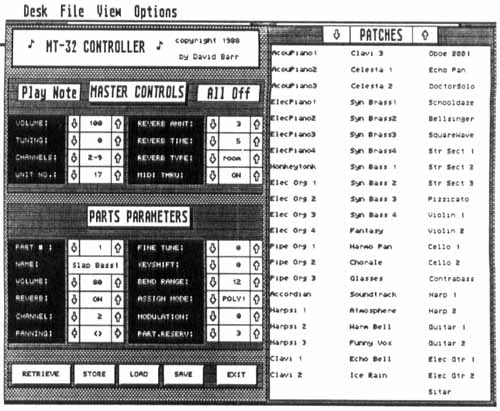
MT-32 Controller
Polysoft
P.O. Box 69541
Portland, Oregon 97201
(503) 245-3152
$49.95; Medium or high resolution
Reviewed by
Michael Friesen
What defines a useful piece of software? That's a good question to throw onto the bulletin board next time things get boring. The MT-32 Controller from Polysoft prompted me to ask myself this question. For although the program does some genuinely useful things, it has enough idiosyncracies to occasionally hamper the musicmaking process.
This is a desk accessory, but you may want to beware of what kind of software you team it up with. Because the program grabs many interrupts, you might find that some screen functions are slower than normal. Programmer David Barr assures me that sequencer timing is not affected.
Along with the main program are three additional files. The first two are banks of 64 sounds. The other file is a "translibrarian;' which allows you to load (from disk) and store (to synth) banks of sounds. This program is compatible with any synth supported in the Controller series: Roland's D-110, MT-32, Yamaha TX81Z and FB-01 and the Kawai K1.
The program is not copy protected and must be installed in the root directory of your boot drive. It will run either in medium or in high resolution.
The program's functions can be divided into two distinct areas: patch librarian and front-panel expander. Both functions reside on a single screen.
The
Front Panel
The panel expander is where this program scores most
of its merit points. The expander takes up the left-hand portion of the
screen and gives you quick and easy access to Master and Part controls.Reverb, pan, trigger mode and fine-tuning are some of the parameters this program gives you access to. Even though many of the parameters are already available from the front panel of the synth, it's nice to have them all laid out in an easy-to-see format.
Parameter values are changed by left-clicking on Up or Down arrows to either side of a parameter. Left-clicking inside the parameter box sets the value to a sensible default. If you're accustomed to a quick mouse, you may have to reset the speed to fine-tune some of the parameters. Sometimes it's hard to stop the mouse just at the value you want.
The
Right Stuff
The right mouse button is put to good use. Clicking
on the right button gates the sound selected for the current part.
Holding the button down sustains the sound, and removing your finger
from the button starts the release cycle.Here's the neat part: Pitch and velocity are determined by y and x positions of the mouse. Rightclicking while the pointer is in the upper-right corner will gate a highpitched note at a high velocity. Lower-left will give you a note with a low pitch at a low velocity. This is a great idea, since it makes use of the oft-ignored right button.
Librarian?
Whatever the ads and the packaging might say, this
is not a patch librarian. It simply does not conform to the standards
of what a patch librarian can reasonably be expected to do.On the good side, the program will give you access to both banks of ROM sounds (the presets), as well as one additional bank of 64 sounds. Each bank is displayed as a whole, all 64 patches at a time. Even though the font is necessarily small, it's nice to be able to pick from 64 on-screen sounds.
New sounds can only be loaded into the MT-32 Controller if the file of 64 sounds has already been saved in the Controllers unique format. And it is impossible to swap sounds between banks. These two factors weigh heavily against the program. Here's why:
You can only get new sounds into the Controller if they have already been saved in the proprietary format. If you buy a bank of sounds, they will either need to have been saved in Controller format, or you'll have to find a way to send them to your synth. Once the sounds are resident in the MT 32, you can use the Retrieve function to get the sounds into the Controller and then save them to disk.
This means that, unless you're content to play around with the two new banks and the two banks of presets, you'll need to buy a patch editor or librarian before you can start messing around with more sounds.
And because you can't shuffle sounds between banks (or even within a bank), there's no way to remap sounds or create performance banks. You'll need to buy a patch librarian to be able to do that.
The
Sound Banks
The two new banks of sounds supplied with the
program represent the usual mix of weird effects, the requisite
attempts at a piano, some nice strings and a few absolute killers. My
own favorite is the Rock Organ patch in the D50 bank.Some of the sounds appear to be either misnamed or have had their data grossly scrambled. All in all, though, they're a nice addition, giving the user an alternative to ROM presets.
The
Bottom Line
It's hard to pin down exactly where this program
should fit into the scheme of things. The Master and Part controls are
useful, but at least partly duplicated on the front panel of the synth.
And the librarian can only deal in terms of whole banks of patches that
have been stored in the Controllers proprietary format. Unless your
librarian is a real monster, which won't work as a desk accessory, the
librarian side of the program hasn't got a lot to offer.Given the kind of stiff competition on the market, even a $50 program should meet certain levels of performance. Yet this program has no printing, no ability to assemble custom banks, and leaves you stuck with that proprietary file format, requiring you to have another patch editor or librarian before you can do any serious work with your synth.
In strictly economic terms, this program doesn't offer enough to justify its price. Fifty dollars is too much to pay just to access a few new functions.

Michael friesen has worked as a bookbinder, a chicken-shed cleaner, a cow milker, a ditchdigger, a jingle composer and a synthesist for a touring theatre company. A MIDI fanatic, he likes to annoy retailers by asking them about products that haven't yet been released.